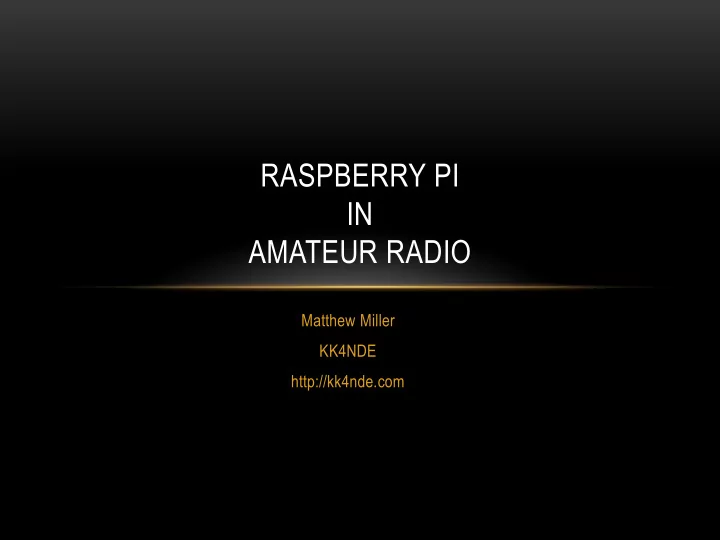

RASPBERRY PI IN AMATEUR RADIO Matthew Miller KK4NDE http://kk4nde.com
WHAT IS RASPBERRY PI Raspberry Pi Conventional PC • Runs Linux operating system • Runs Linux, Windows, MacOS, etc ARM Processor Intel x86 or x86-64 Processor • • • Single SD card for storage • One or more hard-drives for storage Fixed RAM for working memory RAM modules for working memory • • • USB ports for peripherals • USB ports for peripherals Network interface (depends on model) Network cards • • • Expandable with “HATs” • Expandable with PCI cards Configurable Input/Output connections Audio card • •
WHAT IS RASPBERRY PI Raspberry Pi Arduino • Runs Linux operating system • Single-purpose programming ARM Processor Programmable Microcontroller • • • Single SD card for storage • Integrated EEPROM storage Fixed RAM for working memory Integrated RAM for working memory • • • USB ports for peripherals • Expandable with “Shields” Network interface (depends on model) Configurable Input/Output connections • • • Expandable with “HATs” Configurable Input/Output connections •
OVERVIEW OF VERSIONS Model B Model A+ Pi 2 Pi 3 Pi Zero Pi Zero W Cost Outdated $20 $35 $35 $5 $10 USB 2x USB-A 1x USB-A 4x USB-A 4x USB-A 1x OTG 1x OTG Network 10/100M 10/100M 10/100M WiFi 2.4GHz 2.4GHz Bluetooth Yes Yes RAM 512MB 256MB 1GB 1GB 512MB 512MB CPU 1 core 1 core 4 cores 4 cores 1 core 1 core 700MHz 700MHz 900MHz 1.2GHz 1GHz 1GHz GPIO Male Pins Male Pins Male Pins Male Pins Thru-Hole Thru-Hole
EXAMPLE PROJECTS • General purpose computer Mini Desktop/TV Computer • • Mini Server Streaming box • • …ok, so what? This is an Amateur Radio group.
EXAMPLE PROJECTS • Connect to radio Remote rig operation • • Repeater controller Echolink controller • • APRS digipeater APRS i-gate • • …and more! Use SDR instead of radio • • Mostly plug and play but RX-only Maybe some full TX-RX capable SDR could work, sounds expensive •
EXAMPLE PROJECTS - ECHOLINK V1 & V2
EXAMPLE PROJECTS - DIGIPEATER
INTERFACING A SDR • USB – just plug it in May require drivers •
INTERFACING A RADIO • Connections similar to TNC Audio input/output • • PTT and/or COS signals Solutions • • Commercial all-in-one (e.g. Signalink) Homebrew interface •
INTERFACING A RADIO • Commercial all-in-one solution Boring • • Expensive May need to find drivers •
INTERFACING A RADIO • Audio input/output No built in mic/line-input • • Recommend USB sound-card Should have some sort of simple isolation between soundcard and radio • • 1:1 audio transformer • Capacitors • Resistors
INTERFACING A RADIO • PTT/COS signals GPIO-pins directly controlling • • Depends on application support Built-in serial on GPIO – configure CTS/RTS capability • • Annoying OS configuration settings to worry about • Problem, at bootup or crash settings reset, may default to key up radio • External serial adapter with CTS/RTS capability • Can be hard to find serial adapters with CTS/RTS (note RTS ≠ DTR) • Usually chip defaults to proper “idle”, default to un -key radio
INTERFACING A RADIO • For flexibility, I am trying to make this modular and compatible with most software USB soundcard + DIY isolation (1:1 transformers) • • USB serial with CTS/RTS to opto-isolator for PTT Have not played with COS return on serial breakout yet, the radio I have with output does • not provide sufficient power to switch an opto-isolator (maybe a transistor would work) Serial USB RTS Pin PTT Breakout DIY Interface Radio Computer Board Transceiver Spk Mic Sound USB Card Mic Spk
INTERFACING A RADIO • USB soundcard + DIY isolation (1:1 transformers) (not used) Speaker Ground USB Soundcard Connections USB Soundcard Radio Speaker Microphone Ground Ground Audio Isolation Transformer e.g. from car aux-in (not used) Ground Mic USB Soundcard Radio Microphone Speaker Ground Ground Audio Isolation Transformer e.g. from car aux-in
INTERFACING A RADIO • USB serial with CTS/RTS to opto-isolator for PTT Opto- isolator makes it easy to “invert” the serial chip which goes to 0V when it’s • “triggered” and also has to be protected from higher voltages (my radio uses +8V for PTT pin and the serial chip can only stand up to 3.3V) 3V TTL - 180 Ω Opto-Isolator 5V TTL - 330 Ω Radio PTT TTL Serial VCC TTL Serial RTS Radio GND 3V TTL - 180 Ω 5V TTL - 330 Ω LED (visual PTT indication)
INTERFACING A RADIO • Have not played with COS return on serial breakout yet, my radio’s output won’t power an opto-isolator • I think I would use either a transistor or resistor w/ 3.3V or 5V zener-limiter depending if it needs inverting and what voltage the serial adapter uses. • This is an example of the interface I used for 3.3V GPIO connections, It should work the same way for the serial CTS connection if the radio is +V idle and 0V on squelch open. Important thing is to limit the maximum voltage going into the serial chip to no more than • its VCC (typically 3.3V or 5V depending on the chip) – this is easy to with a zener diode. 100 Ω CTS Radio COS 3.3V GND Zener
HARDWARE • USB serial adapter Tested: SparkFun Serial Basic Breakout - CH340G (needs chip-soldering to get RTS) • https://www.sparkfun.com/products/14050 Not Tested: SparkFun USB to Serial Breakout - FT232RL (all pins on thru-hole pads) • https://www.sparkfun.com/products/12731 USB soundcard • • Tested: SYBA external USB Stereo Sound Adapter with Microphone (uses C-Media chipset) https://www.amazon.com/gp/product/B001MSS6CS/
SOFTWARE • Raspbian Linux (Debian based for Raspberry Pi on ARM) USB serial adapter is typically “/dev/ttyUSB0” • • USB soundcard is typically "plughw:1,0” APRS Software • • APRX and Soundmodem (radio + soundcard/PTT) pymultimonaprs (USB RTL-SDR) • • Repeater & Echolink Software • svxlink – highly configurable repeater, simplex-repeater, echolink, etc. controller OpenRepeater project (haven’t used this myself but it’s another repeater controller) • • Digital modes FlDigi (haven’t tried this myself but it sounds promising) •
Recommend
More recommend